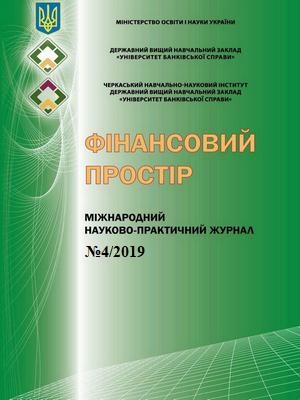Ризики використання віртуальних валют для цілей легалізації (відмивання) коштів, здобутих злочинним шляхом
DOI:
https://doi.org/10.18371/fp.4(36).2019.190200Ключові слова:
віртуальні валюти, фінансовий моніторинг, ризики, відмивання коштів, фінансування тероризму, кіберзлочинністьАнотація
В статті здійснено узагальнення позицій міжнародних організацій та урядів країн світу до правового статусу віртуальних валют; дослідження концептуальних положень FATF і Ради Європи до розуміння та зниження ризиків у сфері ПВД/ФТ, пов’язаних з віртуальними валютами. Обгрунтовано можливість використання віртуальних валют для цілей відмивання коштів, фінансування тероризму, кібершахрайства, ухилення від сплати податків за рахунок невизначеності їх економічної сутності та правового статусу, відсутності контролю з боку суб’єктів фінансового моніторингу та органів державної влади, а також таких особливостей як доступність, швидкість обігу, анонімність. Виявленно характеристичних особливостей сукупності можливих ризиків використання віртуальних валют, окреслено підходи організації фінансового моніторингу та нагляду за операціями із використанням віртуальних валют для мінімізації ризиків, загроз і негативних впливів.
Посилання
Virtual currency schemes. European Central Bank. (2012, October). Retrieved from: https://www.ecb.europa.eu/pub/pdf/other/virtualcurrencyschemes201210en.pdf.
Pflaum, I.& Hateley, Е. (2014). “A bit of a problem: national and extraterritorial regulation of virtual currency in the age of financial disintermediation. – Georgetown Journal of International Law”, 45. 1169-1215. Retrieved from: http://www.law.georgetown.edu/academics/law-journals/gjil/recent/upload/zsx0041 4001169.pdf.
Directive 2009/110/EC of the European Parliament and of the Council of 16 September 2009 on the taking up, pursuit and prudential supervision of the business of electronic money institutions amending Directives 2005/60/EC and 2006/48/EC and repealing Directive 2000/46/EC. Retrieved from: https://eur-lex.europa.eu/legal-content/en/ALL/?uri=CELEX%3A32009L0110.
Directive (EU) 2018/843 of the European Parliament and of the Council of 30 May 2018 amending Directive (EU) 2015/849 on the prevention of the use of the financial system for the purposes of money laundering or terrorist financing, and amending Directives 2009/138/EC and 2013/36/EU. Retrieved from: https://eur-lex.europa.eu/legal-content/EN/TXT/?uri=CELEX%3A32018L0843.
Burdonosova, M.A. (2019). Teoretyko-pravovyy analiz derzhavnoho rehulyuvannya kryptovalyuty v Ukrayini [Theoretical and Legal Analysis of State Regulation of Cryptocurrency in Ukraine]. Aktualʹni problemy vitchyznyanoyi yurysprudentsiyi – Current Issues in Domestic Jurisprudence, 1. Retrieved from: http: //apnl.dnu.in.ua/1_2019/4.pdf [in Ukrainian].
Kryptovalyuta v sviti: stan, rehulyuvannya i perspektyvy [The cryptocurrency in the world: status, regulation and prospects]. Retrieved from: https://mbnpro.com.ua/cryptocurrency-in-world-state-regulation-and-perspectives [in Ukrainian].
Warning to consumers on virtual currencies. EBA/WRG/2013/01. 12 December 2013. Retrieved from: https://eba.europa.eu/documents/10180/598344/EBA+Warning+on+Virtual+Currencies.pdf.
EBA Opinion on ‘virtual currencies’. EBA/Op/2014/08. 4 July 2014. Retrieved from: https://eba.europa.eu/documents/10180/657547/EBA-Op-2014-08+Opinion+on+Virtual+Currencies.pdf.
Virtual currencies: Key Definitions and Potencial AML/CFT Risk, FATF, June 2014. Retrieved from: https://www.fatf-gafi.org/media/fatf/documents/reports/Virtual-currency-key-definitions-and-potential-aml-cft-risks.pdf.
Virtual currencies. Guidance for a risk-based approach, FATF, June 2015. Retrieved from: https://www.fatf-gafi.org/media/fatf/documents/reports/Guidance-RBA-Virtual-Currencies.pdf.
Karcheva, H. T. & Nikitchuk, S. M. (2015). Virtualʹni innovatsiyni valyuty yak valyuty maybutnʹoho [Virtual innovative currencies as currencies of the future]. Finansovyy prostir – Financial Space, 2 (18), 24–30 [in Ukrainian].
Nathaniel Popper. How China took Center Stage in Bitcoin’s Civil War. June 29, 2016. Retrieved from: https://www.nytimes.com/2016/07/03/business/dealbook/bitcoin-china.html.
Internet Organised Crime Threat Assessment (IOCTA). 2016. European Police Office (Europol). Retrieved from: https://www.europol.europa.eu/activities-services/main-reports/internet-organised-crime-threat-assessment-iocta-2016.
IRS Virtual Currency Guidance: Virtual Currency Is Treated as Property for U.S. Federal Tax Purposes; General Rules for Property Transactions Apply. Retrieved from: https://www.irs.gov/pub/irs-drop/n-14-21.pdf.
FinCen Guidance. FIN-2019-G001/ May 9, 2019. Retrieved from: https://www.fincen.gov/sites/default/files/2019-05/FinCEN%20Guidance%20CVC%20FINAL%20508.pdf.
Regulation of Cryptocurrency Around the World. Retrieved from: https://www.loc.gov/law/help/cryptocurrency/world-survey.php.
Cryptocurrencies are ‘clearly shaking the system,’ IMF’s Lagarde says. Retrieved from: https://www.cnbc.com/2019/04/11/cryptocurrencies-fintech-clearly-shaking-the-system-imfs-lagarde.html.
Virtual currency schemes – a further analysis. European Central Bank. February 2015. Retrieved from: https://www.ecb.europa.eu/pub/pdf/other/virtualcurrencyschemesen.pdf.
Global Emerging Markets Strategy Focus. How bad is Bitcoin for the World? Citi Research Multi-Asset. Dec. 22, 2017. Retrieved from: https://ir.citi.com/6E2oHPHzWm1Wt%2F1FqjcywZsl349qEsO61g8k82zK98 dlnf VHCr TWtg%3D%3D.
Spilʹna zayava finansovykh rehulyatoriv shchodo statusu kryptovalyut v Ukrayini [Joint statement by financial regulators on the status of cryptocurrencies in Ukraine]. Retrieved from: https://bank.gov.ua/control/uk/publish/article?art_id=59735329 [in Ukrainian].
Letter of the State Security Service of Ukraine dated 19.06.2018 No. 04/02 / 02-1909 for clarification. Retrieved from: http://search.ligazakon.ua/l_doc2.nsf/link1/FN046550.html [in Ukrainian].
IMF Staff Discussion Note. Virtual Currencies and Beyond: Initial Considerations. Jan 2016. Retrieved from: https://www.imf.org/external/pubs/ft/sdn/2016/sdn1603.pdf.
Yermack, D., 2013, Is Bitcoin a Real Currency? An Economic Appraisal,” (No. w19747). National Bureau of Economic Research. Retrieved from: https://www.nber.org/papers/w19747.
Lo, S. and J.C. Wang, 2014, “Bitcoin as Money?” Federal Reserve Bank of Boston, Current Policy Perspectives No 14–4, 2014, 14. Retrieved from: https://www.bostonfed.org/publications/current-policy-perspectives/2014/bitcoin-as-money.aspx.
Ali, R., J. Barrdear, R. Clews, and J. Southgate. (2014). “Innovations in Payment Technologies and the Emergence of Digital Currencies,” Bank of England Quarterly Bulletin. Retrieved from: https://www.bankofengland.co.uk/-/media/boe/files/quarterly-bulletin/2014/innovations-in-payment-technologies-and-the-emergence-of-digital-currencies.pdf.
In-depth analysis. Virtual currencies and central banks monetary policy: challenges ahead Monetary Dialogue, European Parliament, July 2018. Retrieved from: https://www.europarl.europa.eu/cmsdata/149900/CASE_FINAL%20publication.pdf.
Rynkova vartistʹ virtualʹnykh valyut [Market value of virtual currencies]. Retrieved from: https://coinmarketcap.com/charts/.
All of the World’s Money and Markets in One Visualization. Retrieved from: http://money.visualcapitalist.com/worlds-money-markets-one-visualization-2017/
##submission.downloads##
Опубліковано
Номер
Розділ
Ліцензія
Під час подання рукопису до журналу автори повинні підтвердити його відповідність всім встановленим вимогам, вказаним нижче. В разі виявлення невідповідності поданої роботи пунктам цих вимог редакція повертатиме авторам матеріали на доопрацювання.
Імена та електронні адреси, вказані користувачами на сайті цього журналу, будуть використані виключно для виконання внутрішніх технічних завдань цього журналу; вони не будуть поширюватись та передаватись стороннім особам.

